Last Chance to Catch NYC's Holiday Notalgia Train
We met the voices of the NYC subway on our nostalgia ride this weekend!


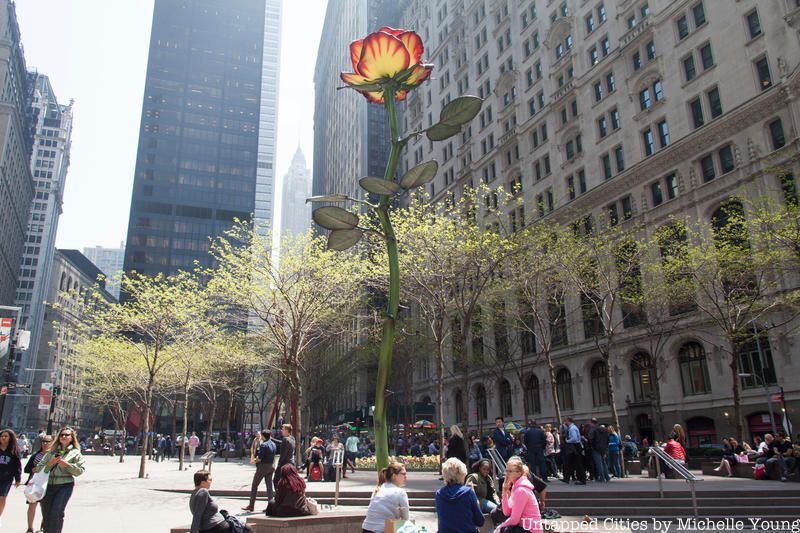
Manhattan’s Zuccotti Park is a 33,000 sq. foot stretch of green located at the intersection between Cedar Street, Broadway, Trinity Place, and Liberty Street. Originally called Liberty Plaza, the park’s name was changed after it was severely damaged by the September 11th attacks.
Over the past two decades, the park — which served as the location of the Occupy Wall Street protests in 2011 — has functioned both as a symbol of the New York working man’s resilience as well as a central hub of protest against Wall Street‘s corporate culture. Its storied history extends hundreds of years before the area actually became a park, and during this time it has amassed an extensive collection of historical, cultural, and architectural secrets.
Many historians believe that the first coffeehouse built in the New World was the King’s Arms, built on the land where Zuccotti Park is now. The coffeehouse opened in 1696 and was owned by Lieutenant John Hutchins, standing on the west side of Broadway between Crown (now Liberty) Street and Little Queen (now Cedar) Street.
The building had a yellow facade imported from Holland, as well as a rooftop observatory that allowed patrons to sit and look out at the ocean over which they had just traveled. It hosted many courtroom trials and business meetings; its rooms were often full of people smoking and reading newspapers; and it had private rooms that could be reserved for discussion or study. Whereas taverns were places for people to unwind, the coffeehouse served as a meeting place where many of the plans for what would become America’s capital city at the time of the Constitution’s ratification were hatched.
Since the first cup was poured at the King’s Arms, New Yorkers have never stopped pumping their veins full of joe. King’s Arms inspired a great many coffeehouses, and the coffee shop still serves a place where New Yorkers work at their notoriously fast pace and congregate to discuss art and politics and every facet of life.
There might be a coffee shop on every corner of the city today, but once upon a time, when New York was mostly trees and rivers, the King’s Arms was a revolution—in more ways than one.
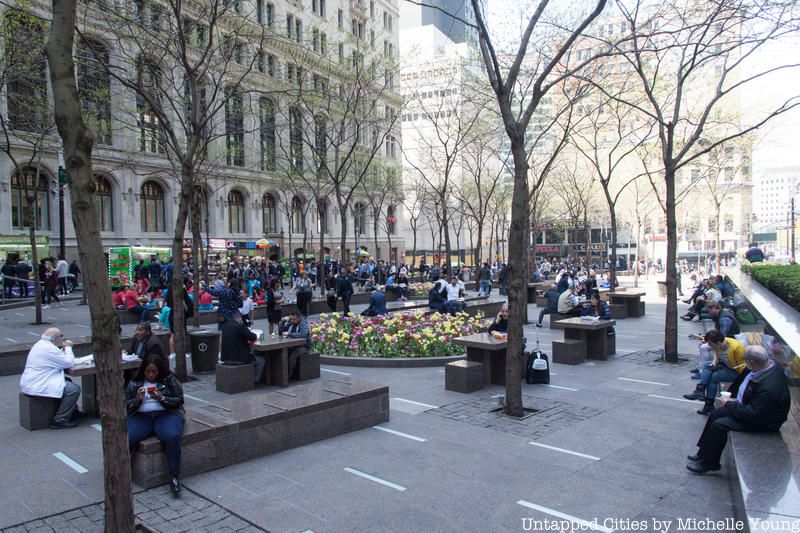
On November 5, 1773, the Sons of Liberty allegedly assembled a large crowd in front of the King’s Arms Coffeehouse to protest the Tea Act; this was perhaps the first public demonstration opposing the statute in the American colonies. Notoriously, England’s aggressive tea tax would eventually inspire the Revolutionary War, which New York played an important role in.
In fact, New York City even had its own version of the Boston Tea Party: on April 18, 1774, a group of riled up New Yorkers dumped out all the tea from a ship parked in the New York Harbor. The next day, they stormed the arsenal on Wall Street and Broad Street, seizing 600 guns. The next year, the Revolutionary War would begin.
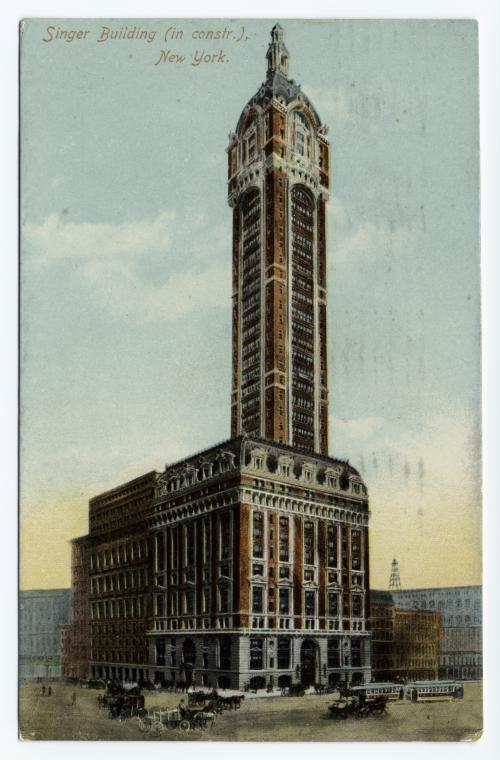
Image from New York Public Library
The first skyscrapers in New York were met with awe and excitement, but as they began to increase in height and volume, many people began to fear that the city’s avenues and streets would become dark, barren valleys, suffused in shadow from the hulking towers above. In 1961, New York City’s Planning Commission adopted a zoning law that controlled the density of development, and also encouraged builders to implement public spaces like parks and gardens in order to break up the darkness and industrial gloom created by the abundance of skyscrapers.
In 1964, the United States Steel purchased the former Singer Building as well as the nearby City Investing Building and demolished both, intending to build a massive skyscraper which would be nine stories higher than zoning laws permitted. The company was eventually successful in their endeavors, on the condition that they would construct a park next to their new building. Zuccotti Park, then called Liberty Plaza Park, was constructed at the base of the former Singer Building in 1968. In 1973, Skidmore, Owings, and Merrill’s fifty-four story United States Steel tower—and the park—opened for business.

The term “mic check” is said to have invented during the Occupy Wall Street protests, when megaphones were banned at Zuccotti Park. The phrase eventually became “a device of the protest itself.” In describing its significance, Occupy activist Jay Gausson noted the following: “We’re so distracted these days, people have forgotten how to focus. But ‘mic check’ demands not just that we listen to other people’s opinions but that we really hear what they’re saying because we have to repeat their words exactly.”
In the book Occupy: Three Inquiries in Disobedience,” authors Willian John Thomas Michell and Bernard E., state that the ban triggered the “most powerful invention of the Occupy movement.” In much of the same way “mic check” commanded attention and facilitated communication, the “human microphone” — or those within earshot of the speaker — relayed words to the people towards the back of the crowds, thus amplifying the voice of the speaker without equipment.
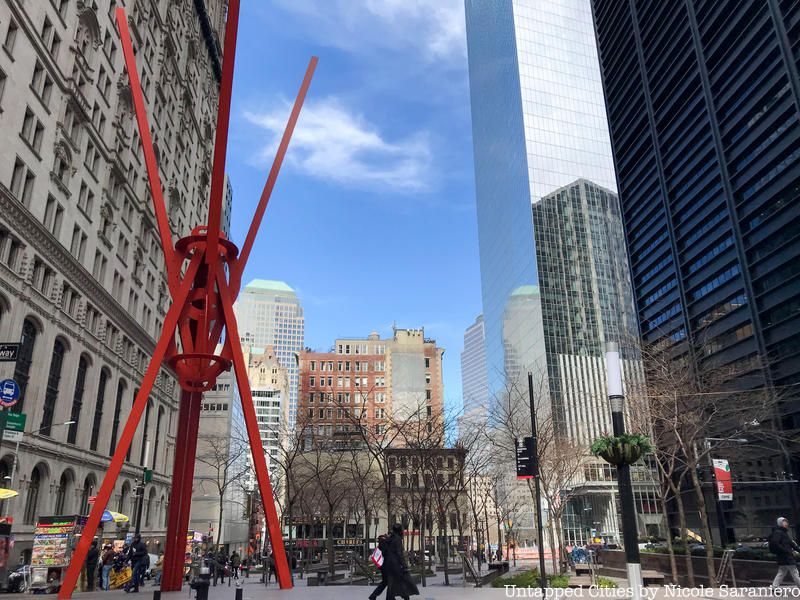
Zuccotti Park is a privately owned public space, which means that although it is privately owned, it is legally required by zoning laws to be open to the public twenty-four hours per day. This makes Zuccotti Park somewhat different from many other New York City parks, most of which close around 1 AM
There are approximately 500 privately owned public spaces in Manhattan. The program was developed in 1961, and allowed for private development of public spaces by investors in exchange for Floor Area Ratio bonuses (FAR).
One of Untapped Cities’ contributors, who has written her thesis on POPs, stated that “as developer priorities are often fiscally driven, most approaches severely limit political, social and democratic functions of public space and produce a constricted definition of the public. As such, privately owned public spaces have deleterious effects on concepts of citizenship and representation, even as they become the new models for urban space provision and management.”
She added that the privately owned public spaces model is especially “problematic when viewed through a lens of citizenship and representation. The right of private parties to exclude certain individuals and groups from publicly accessible spaces is a question of citizenship, or ‘the right to be considered in the range of forums, alliances and nodes which constitute governance.”
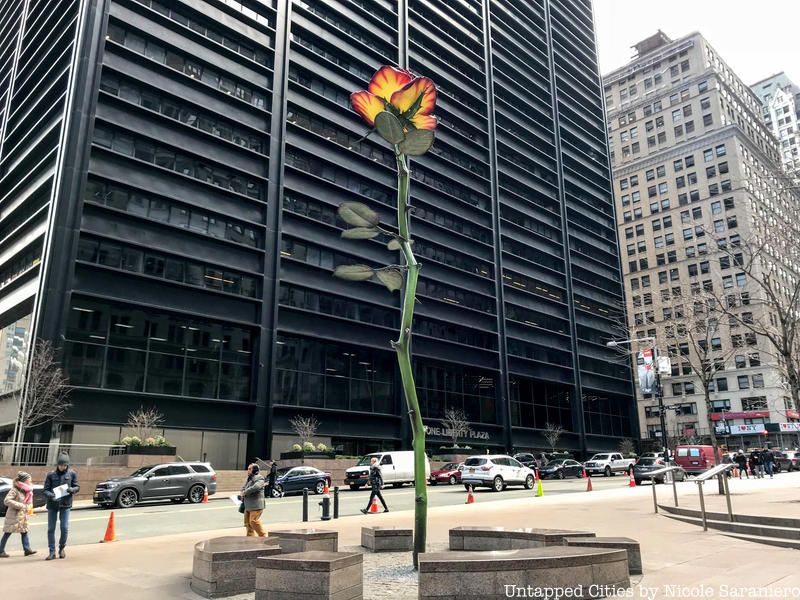
Located one block east of the World Trade Center, Liberty Plaza Park was severely damaged during the 9/11 attacks. Directly following the tragedy, it was used to store emergency vehicles and cleaning equipment, which eventually cracked the park’s foundation due to the weight of all the vehicles.
In light of the damage, the park underwent an $8 million renovation. It was excavated and received newly compacted soil as well as a new design and a new name, which came from John Zuccotti, the U.S. Chairman of Brookfield Properties; it subsequently became a site for several 9/11 anniversaries and memorial services.
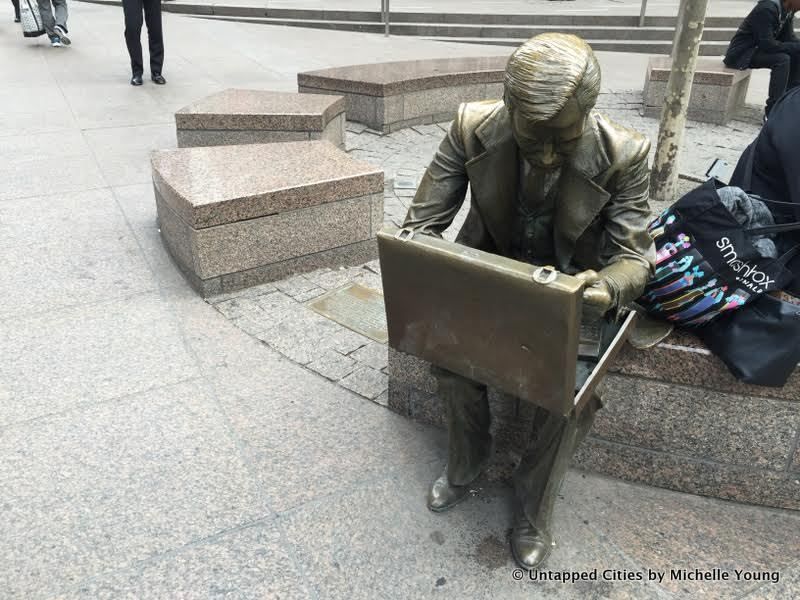
In 1982, John Seward Johnson II created Double Check, a bronze sculpture of a businessman bent over a briefcase and preparing for work. Johnson’s art has been both criticized and praised for its extremely realistic, everyday qualities.
During the September 11 attacks, the statue was allegedly mistaken for a man, and many people on the scene ran towards the statue to ask if it was alright. Photos of the statue covered in debris became iconic emblems of New Yorkers’ post-September 11 resilience, as the statue remained standing despite being heavily pummeled by shrapnel and became a symbol of strength and a memorial following the attacks. Many people placed flowers, candles and notes around the statue, and the very realism for which it had been previously criticized became a venerated icon.
During the Occupy Wall Street protests, the statue yet again became a symbol: protestors stuffed the briefcase with trash and tied a bandana around its head in order to denounce the capitalist society they believed the statue symbolized. Today, the statue has been moved to the corner of Liberty Street and Broadway, part of the One Liberty Plaza. The plaque next to the sculpture reads that it is “a symbol of hope and endurance for us all.”
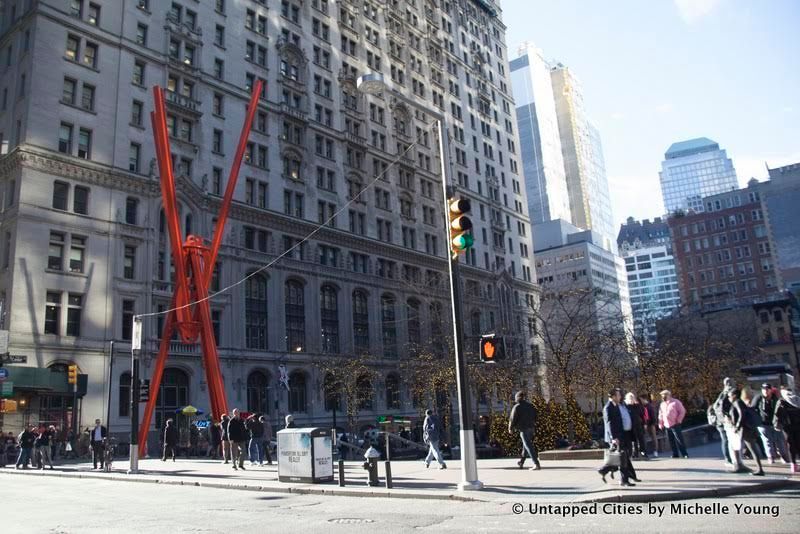
One of the sculptures at Zuccotti Park is the massive Joie de Vivre by Mark di Suvero. Its name means the joy of life in French, and the sculpture—a collision of bright red beams that forms an abstract image of a person raising their arms to the sky—echoes the optimism and energy inherent in its title. The sculpture is made of what the artist has described as ‘open-ended tetrahedrons,’ and was installed in 2006 after previous stints in Paris and at the Holland Tunnel. It merges aesthetic and industrial styles.
Interestingly, the artist Mark di Suvero was not allowed to speak at the sculpture’s unveiling ceremony in 2006, back when the park was still Liberty Plaza Park. di Suvero was a vocal protestor of the Vietnam War and a harsh critic of the Bush administration, and he believed his political views were the reason he was not allowed to speak. “They’re not going to let me talk,” di Suvero, 72, told the Downtown Express in 2006. “Nah, they’re scared. I got arrested during the [Republican] convention for saying Bush lied. I was one of the oldest people that got hauled in.”
It is likely that di Suvero was pleased to hear that in October 2011, during the Occupy Wall Street protests, a man climbed Joie de Vivre and remained there for several hours until taken down by the police.
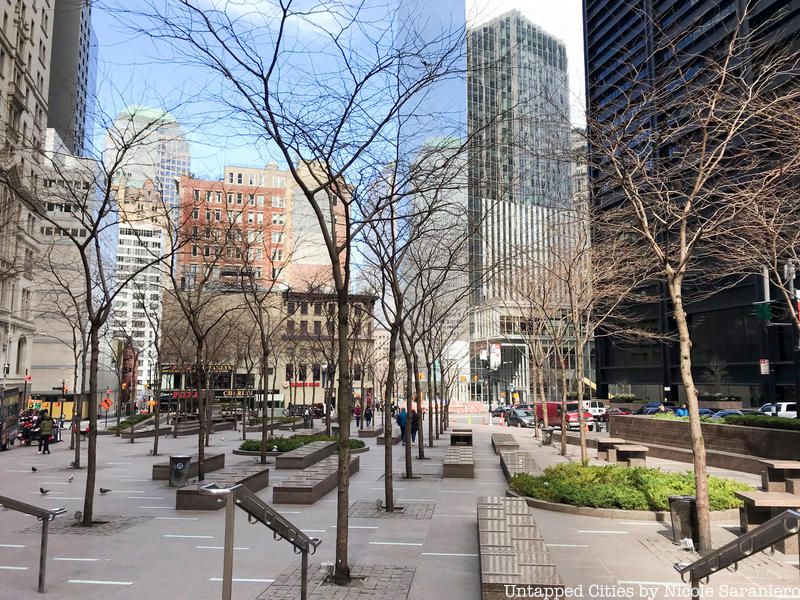
Over two hundred years after the Tea Act protests, the Occupy Wall Street protests took place at Zuccotti Park, in reaction to Wall Street’s corruption, greed, and economic inequality. The movement sparked the rallying cry “We are the 99%.”
Protestors originally set up shop on Wall Street itself, but were moved to the park by the police. They decided to stay in part due to its status as a privately owned public space, which legally allowed people to remain in the park 24 hours per day: throughout the protest, 100 to 200 people stayed in the space at one time. Makeshift sanitation and dining services were set up, and music and chanting could often be heard from the crowd.
On the north-western edge of Zuccotti Park, there was a tree that some Occupy Wall Street protestors christened the “Tree of Life.” During the protests, they placed a plaque at its base that read, “This is a Community Sacred Space. Please feel free to contribute something to the Altar.”
The tree was one of those planted as part of the post-9/11 restoration efforts. Of the 56 planted, 55 were honey locust trees, and one London Plane, which was used as a sacred space for protestors. The tree has since been replaced by Isa Genzken Rose III.
The “Tree of Life” was not the only famous tree in the area. “The Survivor Tree,” a Callery Pear that was rehabilitated after the 9/11 acts, has become a famous memorial at the nearby Ground Zero. Whereas the “Tree of Life” protests the capitalist elite, the “Survivor Tree” honors the resilience and bravery of New Yorkers. Perhaps someday the trees will live in harmony with each other.
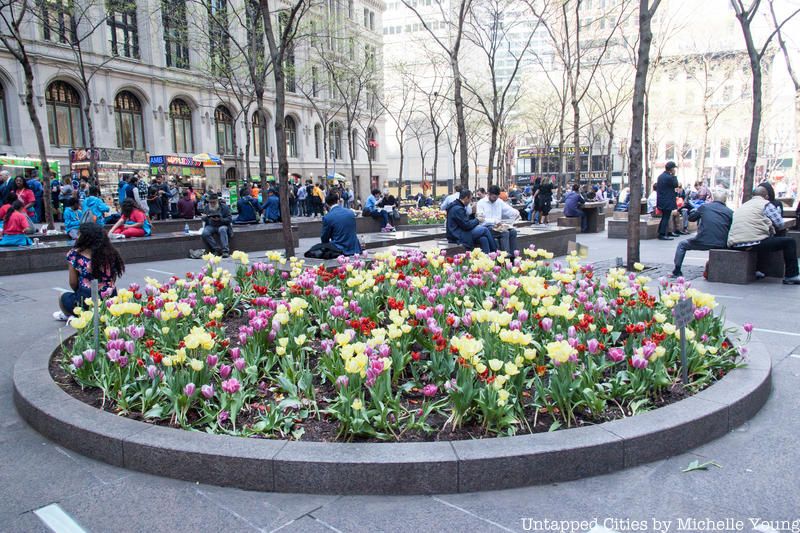
In 2008, Zuccotti Park received the American Institute of Architects Honor Award for Regional and Urban Design, and has been recognized by many magazines for the strength and elegance of its design.
Following 9/11, the park’s architecture was reimagined by Cooper Robertson. Today, it boasts granite benches, tables, and 54 honey locust trees. Food trucks and shade are in ample supply, and the park often hosts concerts and memorial events. It was designed to facilitate diagonal movement in between the subway stations to the west to the Financial District to the east.
Today, businessmen and locals often stop to eat lunch in the company of the trees and flowers that bloom in the spring. At night, Zuccotti Park glows with thousands of lights installed to celebrate the season. Many of these lights are installed directly in the ground, creating a futuristic-looking “light floor” broken by horizontal beams that break up the concrete in a magical and surreal display. The park is especially festive in during the holidays, when the park’s honey locust trees are strung with glittering Christmas lights that provide an effortless passage to a winter wonderland. For this reason, the park is a common tourist destination in the winter.
Zuccotti Park has witnessed a multitude of political turmoil, but today it is an oasis of peace, the perfect place for remembering and reflecting — or for simply forgetting the world and taking a breath — in the midst of one of the busiest sections of Manhattan.
To learn more, check out this article on privately owned public spaces and the Occupy Wall Street protests, or this article on the top 10 secrets of NYC’s McCarran Park.
Subscribe to our newsletter